The medieval period saw the rise of many new inventions all around the world. Emerging out of the so-called Dark Ages, many prominent scholars and learned minds came up with new inventions to make the lives of humankind easier and to bring the prestige of their sovereigns sky-high. Such inventors and scholars did not only exist in Europe, which was always considered the hotspot for new technologies. The skilled Muslim polymath and artisan Ismail al-Jazari is the perfect example.
Credited with numerous ingenious inventions, Ismail al-Jazari authored one of the earliest books that describes them! His unique and inspiring work provides great insight into the rich world of art and science that blossomed in the medieval Muslim world. Join us today as we explore al-Jazari’s life and inventions in detail, and learn how they helped shape the world as we know it today.
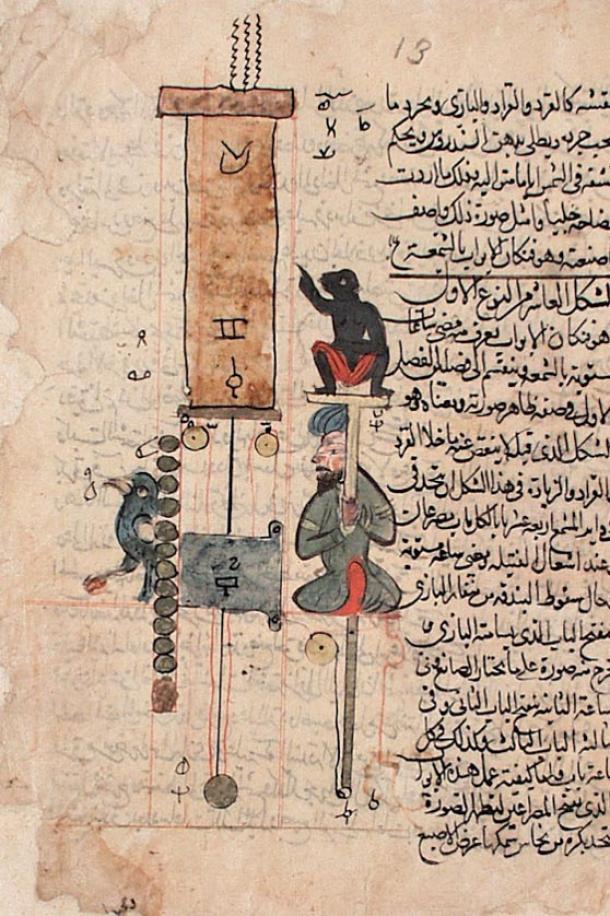
The Book of Knowledge of Ingenious Mechanical Devices, by Ismail al-Jazari, was written in 1206 and includes a detailed description of one hundred devices and inventions along with instructions on how to construct them. ( Public domain )
The Creation of Genius: Early Origins of Ismail al-Jazari
Every man ought to be known by his true name. But, following the age-old Muslim custom, al-Jazari’s full name could be a bit of a challenge to grasp. He was born in 1136 AD, as Badīʿ az-Zaman Abu l-ʿIzz ibn Ismāʿīl ibn ar-Razāz al-Jazarī. The last part of his name, al-Jazari, denotes his place of origin. While history does not remember the exact location of its birth, it is widely agreed that it was in the historic region of Upper Mesopotamia. Some scholars argue that he was born in the town of Jazirat ibn Umar , or his name simply refers to Al Jazira , the traditional name for the Upper Mesopotamia region.
Most of what we know about his life comes from his major work and his biggest achievement: the book known as The Book of Knowledge of Ingenious Mechanical Devices ). A more literal translation of the original Arabic name would be Book in Knowledge of Engineering Tricks . Within his book, it is stated that al-Jazari followed in his father’s footsteps, serving as the chief engineer of the rulers in the Artuqid Palace. The latter was the main residence of the powerful Turkic Artuqid Dynasty, which ruled the region in the 12th and 13th centuries.
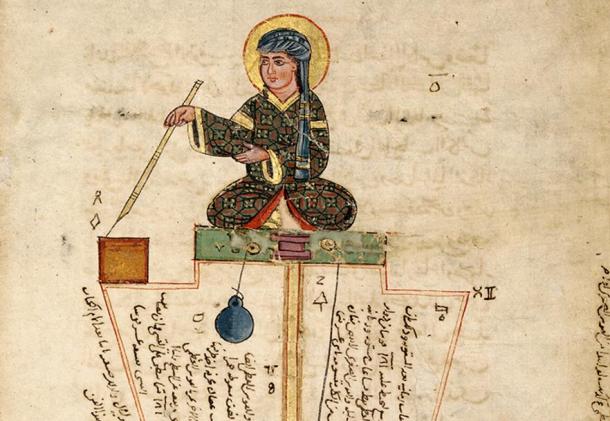
While the genius of Ismail al-Jazari is largely overlooked today, Ismail al-Jazari was a fascinating medieval Muslim inventor. Source: Public domain
His book was written in 1206. In it al-Jazari describes in detail one hundred various devices, as well as providing instructions on how they can be constructed. Out of these hundred, around eighty are “trick devices,” referring to vessels that contain unique trick mechanisms, some of which have been known since antiquity. It is important to note that Ismail al-Jazari was most likely not an inventor in the traditional sense, but rather a devoted and practical engineer possessing the skill to understand the complex approach needed in constructing these unique devices. Nevertheless, this allowed him to come up with a few revolutionary designs, with whose invention he is credited today.
The Book of Knowledge of Ingenious Mechanical Devices repeatedly states that all the devices described within have been built by al-Jazari himself. The uniqueness of these inventions and their efficiency seemingly made al-Jazari a very prominent and popular figure in his lifetime. His book became a sort of medieval bestseller, as numerous copies and manuscripts of it exist. What’s more, the added instructions on how those devices can be made, gave the book a do-it-yourself character, and shared the knowledge with all.
It is well known that the ancient Greeks already pioneered numerous mechanisms and technological innovations, many of which were partially lost with the onset of the “Dark” early Middle Ages. However their concepts remained and Muslim inventors – al-Jazari at their fore – often used them as inspiration and improved their original design.
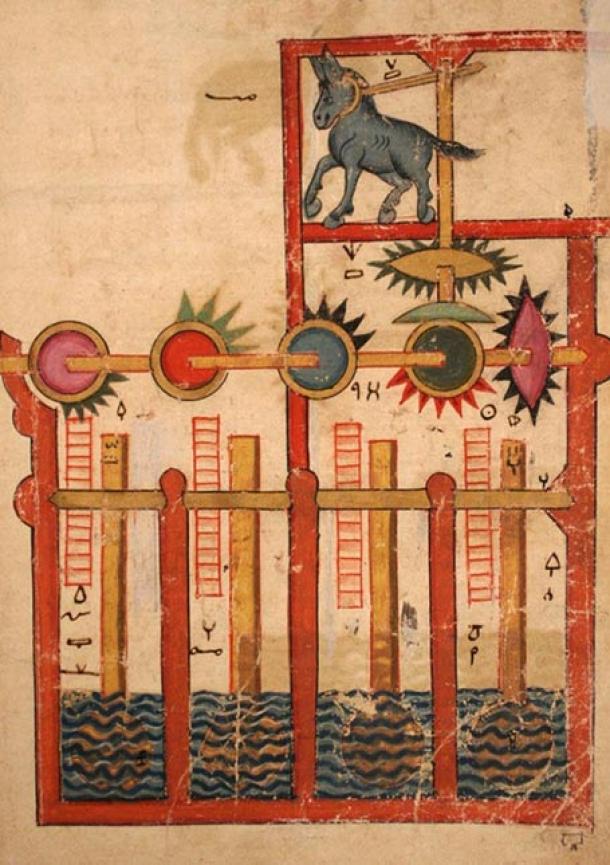
The stunning inventions included in the Book of Knowledge of Ingenious Mechanical Devices, are testament to the brilliant mind of Ismail al-Jazari. This one is a donkey-powered waterwheel. (Metropolitan Museum of Art / CC0)
A Master of Water Movements
People nowadays often disregard the sheer genius of Ismail al-Jazari, and just how advanced his inventions were, centuries ahead of their time. As both an engineer and inventor, al-Jazari possessed the ability to skillfully observe and understand the inner workings of some basic natural principles, which he could incorporate into his own designs. Two of the major mechanisms he relied on were the use of water and the use of camshafts.
A camshaft is a rotating object with special pointed cams, which turns rotational motion into reciprocal motion. Al-Jazari often combined the movement of water and this early camshaft design to create hybrid creations. His heavy reliance on water in his designs earned him the epithet “The Master of Water.”
Ismail al-Jazari’s early crankshaft design was quite skillfully executed, and not in many ways different than the modern one to appear centuries later. His design focused on a large wheel, whose rotation set several crankpins into straight, back-and-forth motion. Known as a crankshaft with a connecting rod, he used this design in two of his personal inventions: the double action reciprocating piston suction pump, and a saqiya crank drive chain pump. Both of these he described in detail.
His crank-driven Saqiya water pump designs were a complex concept that improved the already established tool. With reliance on a crankshaft and numerous connecting gears, al-Jazari’s approach helped minimize the intermittent working cycle of the original design, and created a smoother, continuous work cycle.
His double-action suction pump with valves and reciprocating piston motion was however a true ingenious design, inspired by similar inventions that appeared in the Byzantine world. This complex, elaborate machine was a pioneering invention in many aspects. First of all, it was the first ever use of a true suction pump. It was also the first time a crank rod was used and the first use of the double-action principle. This suction pump could lift 13.4 meters (43.9 ft.) of water, relying on delivery pipes to do so.
The Castle Water Clock is another ingenious mechanical device from Ismail al-Jazari’s famous boo of inventions. ( Public domain )
Earliest Robots in History: To Entertain and Inform
However, the true brilliance of Ismail al-Jazari and his inventions is displayed by his “robots” and automata. Some of the earliest robotics work is ascribed to him and was really a big focus in his career. It shows how advanced his thinking was, and was most certainly something unparalleled at the time. One unique automaton relied on an early hydraulic pump, which measured time as a stopwatch, and whistled when the time was up.
But perhaps the most unique of his automata is his musical robot band. It featured a boat with four artificial robot musicians, who were designed to entertain guests. The robot band is also shown in detail in his book. This invention showcases a complex system of water and rotary cams which were used to set the “robots” and their instruments into motion. It is possible that the main instrument used was the drum, whose tempo could be alternated with the different positioning of the cams. It is written that the musical automaton was very loud and could perform several unique tunes.
This particular design was taken even further, but this time in the form of a clock. Al-Jazari designed a complex artificial band, which served to entertain guests and also tell the passage of time. It consisted of several figures joined together: two cymbal players, two trumpeters, and three percussion instrument players. This unique mechanism served as a form of a clock, producing a short musical performance every hour. This served both a practical and entertaining role.
Like most of al-Jazari’s inventions, this clock was powered by a complex mechanism relying on water, pistons, and cables. The musicians were connected to a large wheel, which was propelled by water. The hourly movements were enabled by slowly dripping water from a large tank into a smaller bucket, which would eventually tip over and initiate the movement. As the hourly movements progressed, another figure on top of the scene would move along, until it reached the end position, triggering a carved falcon that drops a ball out of its beak onto a cymbal, whose jangling sound initiates the daybreak and starts the movement once more.
Candle clocks were known for a very long time, and were not very unique in al-Jazari’s time. However, he greatly improved the design and created one of the most advanced candle clocks of his era. These candles burned at a steady and measured pace, and their diminishing indicated the passing of time. Al-Jazari’s design was complex. It featured a dial to display time, a series of pulleys and counterweights, as well as a first-time use of the popular “bayonet fit,” a connection technique that is still used today. It is stated that a candle clock so sophisticated and refined was never documented elsewhere.
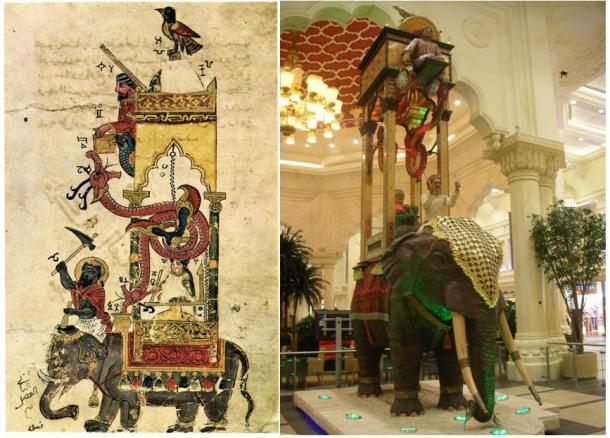
Left: The Elephant Clock from The Book of Knowledge of Ingenious Mechanical Devices by Ismail al-Jazari. ( Public domain ) Right: Reproduction of the elephant clock at the Ibn Battuta Mall in Dubai. ( Public domain )
The Elephant Clock as His Crowning Achievement
It was his famous Elephant Clock that really marked Ismail al-Jazari’s career and remained as his most recognizable invention. This complex water clock was disguised within a large Asian elephant with a traditional “carriage” on top of him. As the name suggests, the clock timing mechanism was based on water movement: a large tank filled with water was hidden with the elephant. In it floated a deep bowl that had a hole in its center – it took half an hour for it to fill up through the hole.
As it sank due to the water filling up, this bowl pulled on an attached string. The latter was in turn connected to a classic seesaw mechanism at the very top of the tower that was on the elephant. As the seesaw tipped over, it dropped a ball into the mouth of the carved serpent that sat in the tower. The serpent angles forward, pulls on a series of strings and retrieves the deep bowl from within the elephant, resetting it. At the same time, the strings initiate the movement of a figure inside the tower, raising its hands and striking into a drum. The entire movement indicates either half an hour or a full hour. The serpent returns to its original position and the system is reset.
When describing his marvelous invention, al-Jazari wrote that “the elephant represents the Indian and African cultures, the two dragons represent Chinese culture, the phoenix represents Persian culture, the water work represents Greek culture, and the turban represents Islamic culture.” This shows his appreciation for other cultures and the work of others, and no intention for him to appropriate the earlier inventions as his own.
Numerous modern reproductions of this ingenious clock have been made, and the design is still as equally astonishing as it was centuries ago, perfectly showcasing the brilliance of al-Jazari’s mind. In Switzerland, in front of the Musée d’Horlogerie du Locle (Clock Museum of Le Locle), in Château des Monts, in Le Locle, there is a full sized, working replica. Another majestic reproduction is housed in Dubai, in the United Arab Emirates, standing as the focal point of the large Ibn Battuta Mall.
While the Elephant Clock was perhaps his most marvelous design, it was eventually surpassed when al-Jazari created his largest creation, the so-called Castle Clock. A complex design, it was not only used to show the passage of hours, but also served as an astronomical clock, displaying the solar and lunar orbits, the zodiac, and a series of automatons. Roughly 3.4 meters (11 feet) high, the clock had a series of intricate mechanisms within.
At every hour, automatic doors in the center would open, revealing a moving figure that would sound the time. Al-Jazari used automaton musicians, a series of figures that played music, again operated by camshafts and water wheels. The design was far ahead of its time, having the ability to reprogram the length of the day, adjusting to the uneven lengths of days during the year, known as the temporal hours. The Castle Clock of al-Jazari is considered today as the earliest programmable analog computer.
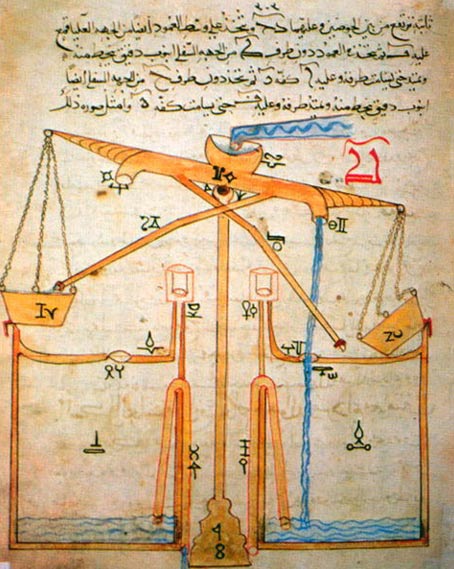
The incredible inventions included by Ismail al-Jazari in his famous book provide a window into the productive world of art and science in the medieval Muslim world. ( Public domain )
The Overlooked Genius of Al-Jazari
The genius of Ismail al-Jazari is largely overlooked today. He, and a series of other medieval Muslim inventors, marked a period in history when humanity quickly moved forward in pursuit of intricate and helpful innovations. It is important to note that perhaps none of al-Jazari’s inventions were of a military nature, or used in negative spheres. Rather, they were intended to help society, make lives easier and more bountiful, and entertaining as well. And thus, in many ways, Ismail al-Jaziri is one of the greatest minds of the medieval age.
Top image: Ancient Muslim man. Credit: Ovsev/ Adobe Stock
References
Al-Jazari, I. 2016. Al Jazari’s Book – The Book Of Knowledge Of Ingenious Mechanical Devices: El Cezeri Kitap. Original Manuscript.
Ceccarelli, M. 2009. Distinguished Figures in Mechanism and Machine Science: Their Contributions and Legacies, Part 2. Springer Science & Business Media.
Cropley, D. 2019. Homo Problematis Solvendis–Problem-solving Man: A History of Human Creativity. Springer.
Various. 2015. Engineering and Technology. Cengage Learning.
Related posts:
Views: 0
 RSS Feed
RSS Feed

















 December 14th, 2020
December 14th, 2020  Awake Goy
Awake Goy 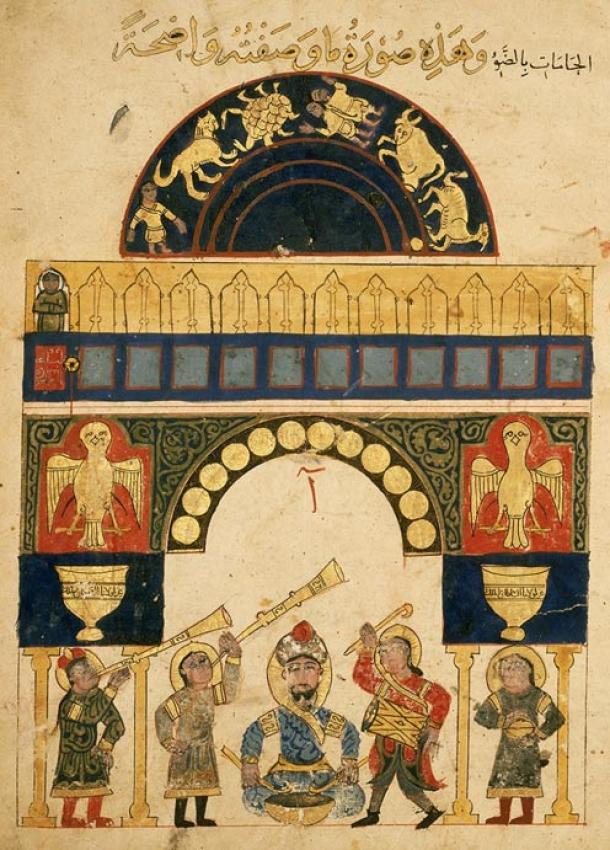
 Posted in
Posted in  Tags:
Tags: 
















